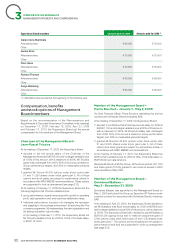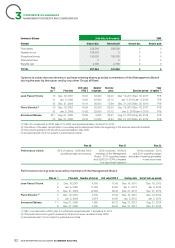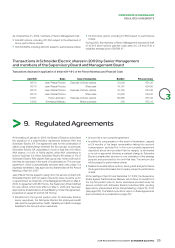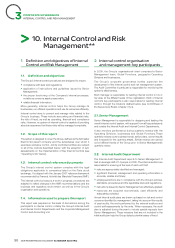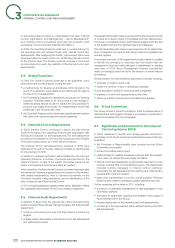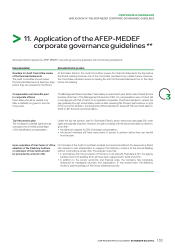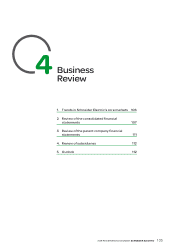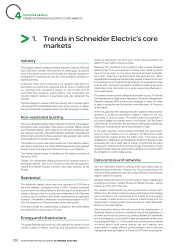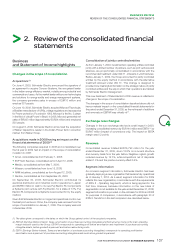APC 2009 Annual Report Download - page 102
Download and view the complete annual report
Please find page 102 of the 2009 APC annual report below. You can navigate through the pages in the report by either clicking on the pages listed below, or by using the keyword search tool below to find specific information within the annual report.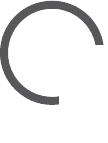
2009 REGISTRATION DOCUMENT SCHNEIDER ELECTRIC100
CORPORATE GOVERNANCE
3INTERNAL CONTROL AND RISK MANAGEMENT
of accounting data provided by consolidated units (see “Internal
Control organisation and Management – Senior Management”
and “Internal control procedures governing the production and
processing of accounting and fi nancial information”).
In 2009, the Operating Divisions continued to provide training for
the operating units and received these units’internal control self-
assessments. After analysing the results, improvement plans were
developed either for certain units or for certain Key Internal Controls
at the Division level. The Division internal controllers conducted
on-site missions to verify the reliability of the internal control self-
assessments.
5.3. Global Functions
In 2009, the Global Functions continued to set guidelines, issue
instructions and provide support. During the year:
•a methodology for drawing up a business continuity plan in the
event of a pandemic was published and distributed throughout
the Group for local application;
•the Purchasing Department distributed procedures for tracking
suppliers’fi nancial health to all Group units so that recession-
related business failures would not impact the Group’s ability to
produce and supply its products. An implementation audit was
performed in the Group’s main units;
•the Corporate Treasury centre developed a global payment system
that offers both secure access and secure payments.
5.4. Internal Control Department
In 2009, Internal Control continued to deploy the Key Internal
Controls throughout the Operating Divisions and businesses, with
training and requests for self-assessments.The self-assessment
process will be repeated in 2010 and will include new units. Results
of the action plans drawn up in 2009 will be monitored.
The internal control self-assessments received in 2009 were
analysed at the end of the year, making it possible to identify areas
for improvement in 2010.
In addition to analyses and action plans initiated by the units and
Operating Divisions, a number of projects were launched in the
Global Functions. In light of the results, the Global Functions will
defi ne and implement improvement plans as needed.
In the meantime, the Key Internal Controls scorecard was expanded
and enhanced. Numerous appendices were posted on the intranet,
with detailed explanations, links to reference documents on the
Functions’intranets, rating assistance, and an identifi cation of the
risks covered by each Key Internal Control.
In 2010, the self-assessment questionnaires will be adapted to refl ect
the organisation al principles of the One company programme .
5.5. Internal Audit Department
In addition to fi ne-tuning the general risk matrix and performing
audits to ensure these risks are managed properly, the Internal Audit
Department:
•monitors and reviews the way that Key Internal Controls are
applied;
•critically reviews the audited unit’s internal control self-assessment
and related action plans.
The Department’s audit missions go beyond the Key Internal Controls
to include an in-depth review of processes and their effectiveness.
The focus on compliance and/or performance is aligned with the size
of the audited unit and the identifi ed risks and challenges.
The internal auditors also review newly acquired units to assess their
level of integration and ensure that Group rules and guidelines are
properly applied.
A summary overview of the department’s audits makes it possible
to identify any emerging or recurring risks that require new risk
management tools and methodologies or adjustments to existing
resources. In 2009, Senior Management ordered unscheduled
audits on emerging risks that led to the revision of certain internal
procedures.
During the year, the internal auditors performed 24 audits, including:
•full audits of medium-sized units;
•audits of a number of risks or operating processes;
•post-acquisition audits for newly acquired companies;
•analyses of control self-assessments by the units;
•follow-up audits to ensure recommendations are applied.
5.6. Fraud Committee
The Group formed a Fraud Committee in 2009 to analyse cases of
detected fraud and suggest changes in procedures or practices to
prevent such cases from occurring again.
5.7. Significant enhancements to the Internal
Control system in 2009
In 2009, measures to identify and manage general risks and to
periodically control audit results and performance were continued.
In addition:
•the Principles of Responsibility were updated and an Ethics
Committee was created;
•a Fraud Committee was formed;
•methodologies for creating a business continuity plan (for example,
in the case of a pandemic) were widely circulated;
•internal control self-assessment questionnaires were sent out over
a scope covering 65% of consolidated revenue. This deployment
included training managers in internal control practices,
conducting the self-assessments and defi ning and implementing
remedial action plans if needed;
•plans were implemented to monitor critical suppliers’fi nancial
situations and create a centralised supplier payment resource.
Further measures will be taken in 2010, including:
•a project to industrialise management of task segregation in the
information systems;
•a process for systematic reporting and analysis of any cases of
fraud detected within the Group;
•broader deployment of the internal control self-assessments;
•monitoring of the improvement plans defi ned following the 2009
self-assessments.


